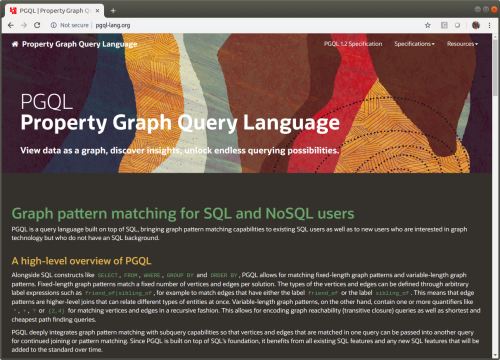PGQL is an SQL-based query language for the property graph data model, bringing graph pattern matching capabilities to SQL and NoSQL users.
See the website for a language specification and any newsworthy updates:
This Git repository contains a parser for PGQL with the following features:
-
Easy-to-understand IR: Given a query string, the parser returns an easy-to-understand intermediate representation (IR) of the query as a set of Java objects
- see GraphQuery.java
-
Query validation: built-in to the parser is a static query validator that provides meaningful caret-style (e.g.
^^^) error messages:Example 1
SELECT n.name, o.name FROM MATCH (n) -[e]-> (m)
Error(s) in line 1: SELECT n.name, o.name ^ Unresolved variableExample 2
SELECT AVG(n.age), n FROM MATCH (n:Person)
Error(s) in line 1: SELECT AVG(n.age), n ^ Aggregation expected here since SELECT has other aggregation -
Pretty printing: invoking
GraphQuery.toString()will "pretty print" the graph query, which turns unformatted queries into formatted ones:SELECT n.name FROM MATCH (n:Person) WHERE n.name = 'Anthony' OR n.name = 'James'
SELECT n.name FROM MATCH (n:person) WHERE n.name = 'Anthony' OR n.name = 'James'
-
Code completion: given a (partial) query string and a cursor position, the parser can suggest a set of code completions, including built-in functions, labels and properties. These completions can for example be used by an interactive web editor. By providing the parser with metadata about the graph (existing properties and labels), the completions will also include label and property suggestions.
PGQL's parser can be built on Linux, macOS or Window.
First install JDK 1.8 or higher and Maven 3.5.4 or higher. Then, follow these instructions:
On Linux or macOS:
- Build and install to your local Maven repository by running
sh install.sh
On Windows:
- Open System Properties and add a new variable
JAVA_OPTSwith value-Xms512m -Xmx1024m -Xss16m - Build and install to your local Maven repository by running
install_on_windows.bat
After you have installed the parser like explained above, parse two example queries:
- On Linux or macOS execute
cd example; sh run.sh - On Windows execute:
cd example mvn clean package exec:java -Dexec.mainClass="oracle.pgql.lang.example.Main" -Dexec.cleanupDaemonThreads=false
public class Main {
public static void main(String[] args) throws PgqlException {
try (Pgql pgql = new Pgql()) {
// parse query and print graph query
PgqlResult result1 = pgql.parse("SELECT n FROM MATCH (n:Person) -[e:likes]-> (m:Person) WHERE n.name = 'Dave'");
System.out.println(result1.getPgqlStatement());
// parse query with errors and print error messages
PgqlResult result2 = pgql.parse("SELECT x, y, FROM MATCH (n) -[e]-> (m)");
System.out.println(result2.getErrorMessages());
}
}
}The AST returned by the parser is a GraphQuery object. This would be the input to your query planner.
See the PGQL Specification.
- Download Eclipse with Spoofax 2.5.18 pre-installed here
- Import the following projects into Eclipse (
File>Import...>Maven>Existing Maven Projects>Browse...):graph-query-ir: Java representation of graph queriespqgl-spoofax: Spoofax implementation of PGQL (parser + error checks)pgql-lang: translation of Spoofax AST intograph-query-ir
This project welcomes contributions from the community. Before submitting a pull request, please review our contribution guide
Please consult the security guide for our responsible security vulnerability disclosure process
Copyright (c) 2023 Oracle and/or its affiliates.
Released under the Apache and the Universal Permissive License (UPL) as shown at https://oss.oracle.com/licenses/upl/.
